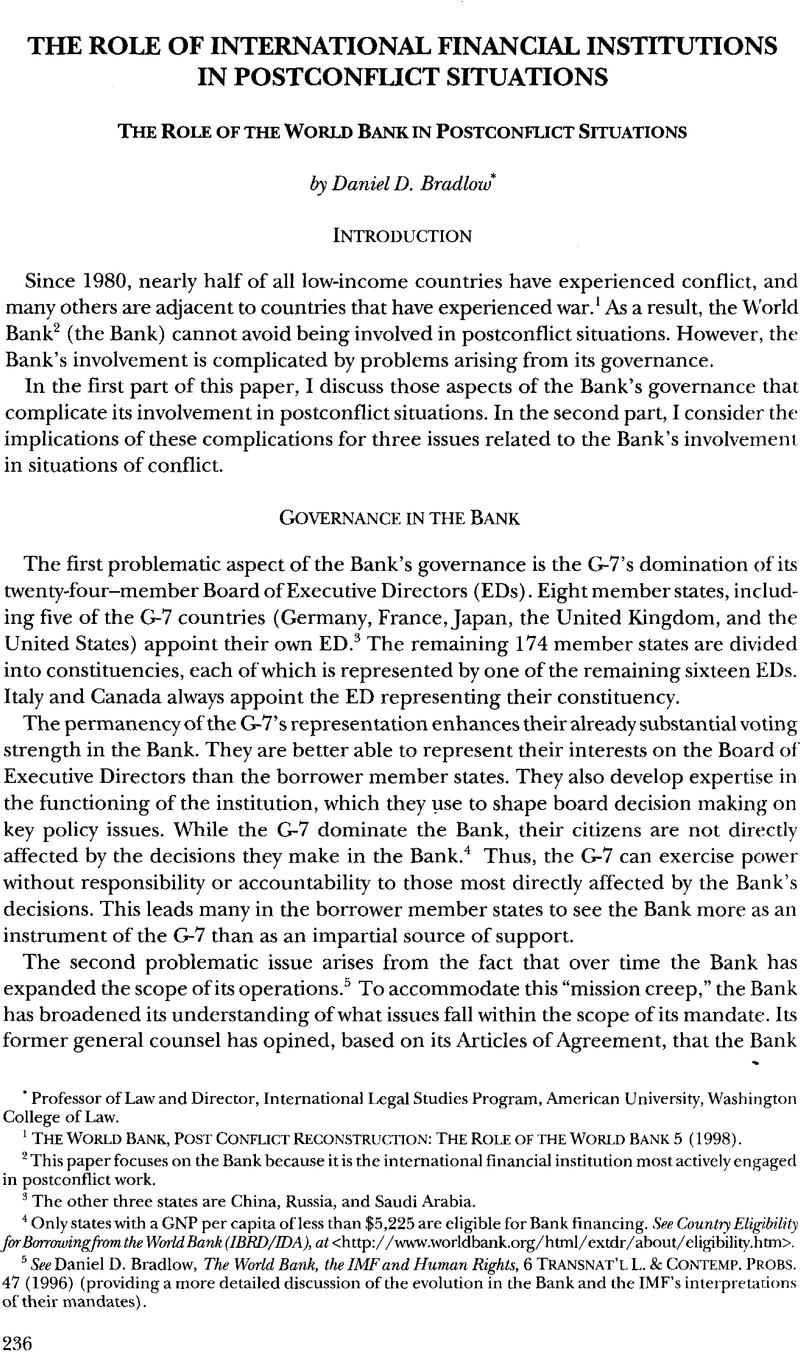No CrossRef data available.
Article contents
The Role of the World Bank in Postconfuct Situations
Published online by Cambridge University Press: 28 February 2017
Abstract

- Type
- The Role of International Financial Institutions in Postconflict Situations
- Information
- Copyright
- Copyright © American Society of International Law 2001
References
1 The World Bank, Post Conflict Reconstruction: The Role of the World Bank 5 (1998).
2 This paper focuses on the Bank because it is the international financial institution most actively engaged in postconflict work.
3 The other three states are China, Russia, and Saudi Arabia.
4 Only states with a GNP per capita of less than $5,225 are eligible for Bank financing. See Country Eligibility for Borrowing from the World Bank (IBRD/IDA), at <http://www.worldbank.org/html/extdr/about/eligibility.htm>.
5 See Bradlow, Daniel D., The World Bank, the IMF and Human Rights, 6 Transnat’l L. & Contemp. Probs. 47 (1996)Google Scholar (providing a more detailed discussion of the evolution in the Bank and the IMF’s interpretations of their mandates).
6 See Shihata, Ibrahim F.I., The World Bank and “Governance” Issues in Its Borrower Countries, in 1 The World Bank in a Changing World 83–84 (1991)Google Scholar.
7 These developments and the Bank’s approach to postconflict situations is described in the World Bank, supra note 1.
8 See The World Bank Operational Manual, at OP 2.30 and BP 2.30 (July 1994), available at <http://www.worldbank.org>.
9 Id. paras. 3, 4.
10 Articles of Agreement of the International Bank for Reconstruction and Development, July 22, 1944, Art. IV(10), 60 Stat.1440, 2 UNTS 134, as amended 16 U.S.T. 1942 [hereinafter Articles of Agreement].
11 See The World Bank Operational Manual, supra note 8.
12 The Bank’s Articles require it to take the ability of the borrower to repay its debts to the Bank into account in its lending decisions. E.g., Articles of Agreement, supra note 10, at Art. Ill, sec. 4(v).
13 See e.g., Orford, Anne, Locating the International: Military and Monetary Interventions after the Cold War, 38 Harv. Int’l L. J. 443 (1997)Google Scholar (arguing the IMF’s intervention in the former Yugoslavia contributed to the subsequent problems in that region).
14 Asmal, Kader, International Law and Practice: Dealing with the Past in the South African Experience, 15 Am. U. Int’l L. Rev. 1211 (2000)Google Scholar.
15 See Agreement Between the United Nations and the International Bank for Reconstruction and Development, 16 UNTS 346 (1948) ; Agreement Between the United Nations and the International Development Association, GA Res. 1594, UN GAOR, 15th Sess., Supp. No. 16A (1960).
16 The World Bank Operational Manual, supra note 8, at para. 2 (a).
17 See Algira Kreimer, John Eriksson, Robert Muscat, Margaret Arnold, & Colin Scott, The World Bank’s Experience with Post-Conflict Reconstruction (1998).
18 World Commission on Dams, Dams and Development: A New Framework for Decision Making (2000).


